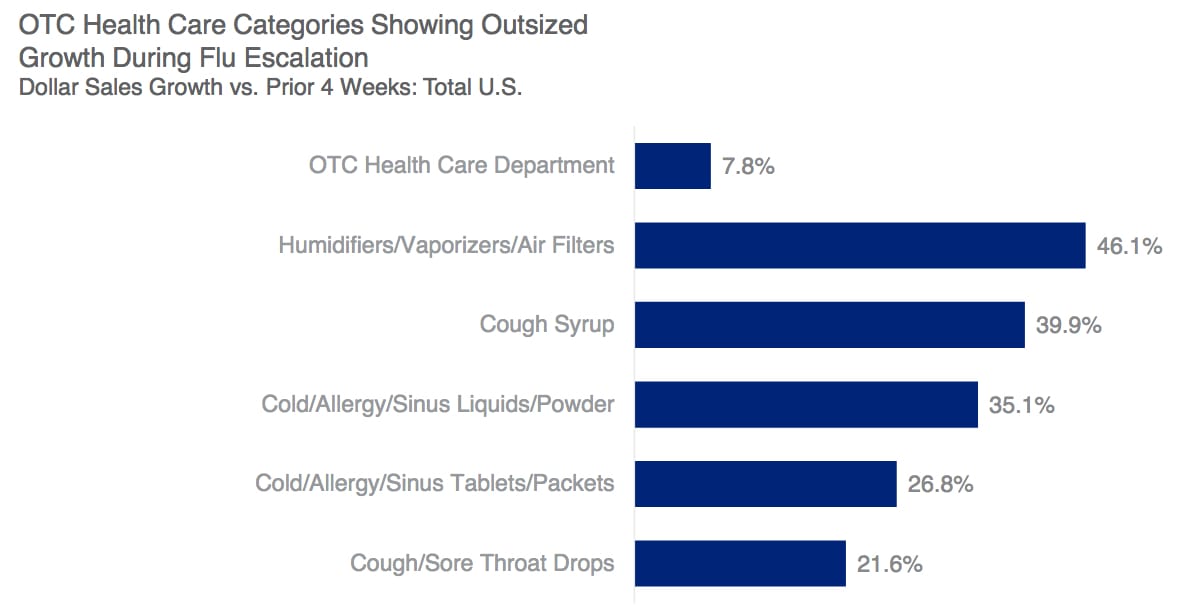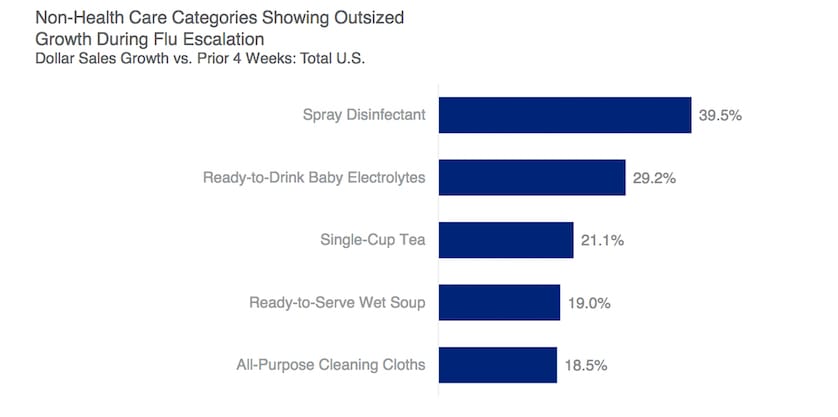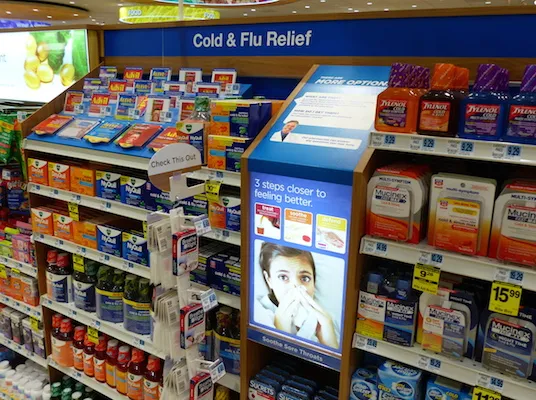NEW YORK — The escalating number of flu cases nationwide has hoisted sales of over-the-counter medicines and other products that help treat and manage flu symptoms, according to market research firm IRI.
In a new report titled “Flu Fury: IRI Pinpoints How Flu Is Impacting U.S. Markets,” IRI spotlights areas hit hard by the spread of the flu virus and how this correlates with purchase behaviors in related consumer packaged goods (CPG) categories. About 5% of the U.S. population is currently suffering from the flu, the report said.
The IRI Flu Fury research, released Wednesday, helps retailers gauge inventory needs and avoid the typical 4% sales loss caused by out-of-stock products.
For the four weeks ended Jan. 14, overall OTC health department dollar sales rose 7.8% versus the previous quarter, IRI said. Big gains were seen in such flu-related categories as humidifiers/vaporizers/air filters (+46.1%), cough syrup (+39.9%), cold/allergy/sinus liquids and powders (+35.1%), cold/allergy/sinus tablets and packets (+26.8%) and cough/sore throat drops (+21.6%).

Source: IRI Illness Tracking, four weeks ended Jan. 14, 2018
Meanwhile, many non-health CPG categories also are experiencing spikes and variations in sales that correlate to the spread of flu across the country, the IRI Flu Fury research finds.
For example, IRI reported that for the same four-week period, quarter-to-quarter dollar sales of spray disinfectant jumped 39.5%, while read-to-drink baby electrolytes saw a 29.2% sales boost. Also seeing large increases were single-cup tea (+21.1%), ready-to-serve wet soup (+19%) and all-purpose cloth cleaners (+18.5%).

Source: IRI Illness Tracking, four weeks ended Jan. 14, 2018
“We all know what it feels like to shop for medicine when you’re sick, only to find an empty peg or shelf. When this happens, one-third of consumers will make their purchase at a different store, and fewer than half will make a substitute purchase,” Bob Sanders, executive vice president of IRI’s Health Care Practice, said in a statement.
“Manufacturers and retailers must be prepared when the flu sweeps through town,” Sanders noted. “Since market nuances are very important, we leveraged the IRI Illness Tracking to uncover flu trends market by market and store by store, so consumers from Little Rock to Houston don’t have to face that dreaded empty shelf.”
IRI Illness Tracking indicates that flu has become widespread nationwide, and IRI said it will take weeks before the epidemic dissipates.
The South Central U.S. has seen the highest incidence of flu, though it also has become prevalent in western states like Arizona and California as well as in Great Lakes states like Minnesota, Illinois, Indiana and Ohio.
IRI said the Houston market has been hit especially hard, with 11.8% of its population fighting the flu. Right or not far behind are New Orleans (11.7% battling the flu); Mobile, Ala. (11.7%); San Diego (11.7%); Dallas (11.1%) and St. Louis (9.9%).
In certain product categories, the dollar sales impact of widespread flu was apparent in these markets. For example, the IRI Flu Fury report noted that cough syrup sales jumped 46.1% in Houston and 99.3% in San Diego. Similarly, sales surged 40.6% in Houston and 83.8% in San Diego for cough/allergy/sinus liquid and powder and soared 43.9% in Houston and 74.3% in San Diego for spray disinfectant.

Source: IRI Illness Tracking
“With health officials reporting that this year’s flu season is now more intense than any since the 2009 swine flu pandemic, retailers must invest to understand the impact this type of event has on their sales and shopper interactions. They simply can’t paint a broad brush stroke across their stores and end up with an accurate picture,” explained Susan Viamari, vice president of thought leadership for IRI.
“You really need to look at stores by specific markets. Because stock-outs will have a major negative impact on sales, and that can hit the bottom line very hard, translating to $40 million per year for a billion-dollar retailer,” noted Viamari.
The nation’s largest drug store operators — Walgreens Boots Alliance (WBA) and CVS Health — stand to benefit the most from increased incidence of flu, according to Jefferies analyst Brian Tanquilut.
He said in a research note this week that Jefferies’ analysis of the latest Centers for Disease Control and Prevention (CDC) flu data indicates that the number of weekly doctor visits has climbed to a 20-year high, reaching 69,000 in the fourth week of January. Similarly, the percentage of visits for influenza-like illness (ILI) has hit an eight-year high.
“An increase in flu diagnoses and physician visits is a tailwind for the drug retailers, as it typically results in a pickup in volumes for either the pharmacy (for those patients who receive scripts for prescription medications such as Tamiflu) or the front-end (for those patients who purchase over-the-counter medications),” Tanquilut wrote. “Additionally, the foot traffic that the flu brings to the retail pharmacies could drive incremental front-store volumes.”
In its weekly Walgreens Flu Index for the period ended Feb. 3, WBA reported that Wyoming, North Carolina and Tennesee were the states with the biggest flu activity gains. They were followed by Delaware, New Jersey, New Hampshire, Virginia, Massachusetts, Georgia and Montana in terms of rising flu activity.
Overall, the top 10 states with the most flu activity were Oklahoma, Texas, Arkansas, Alabama, South Carolina, Mississippi, Tennesee, Kansas, Wyoming and Louisiana for the week ended Feb. 3, according to the Walgreens Flu Index.









